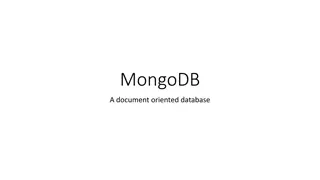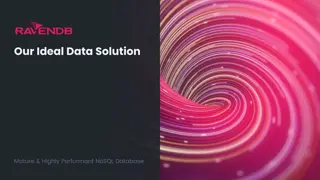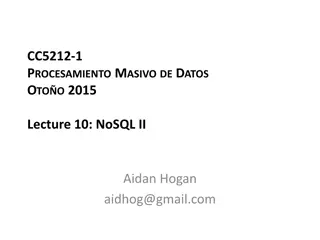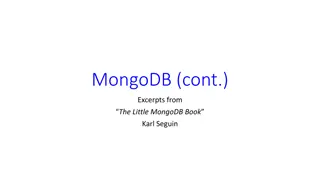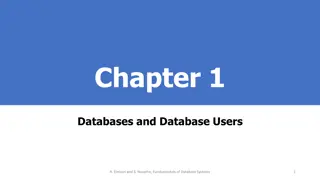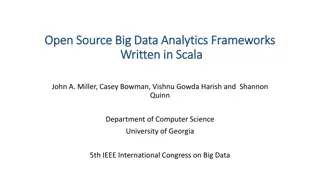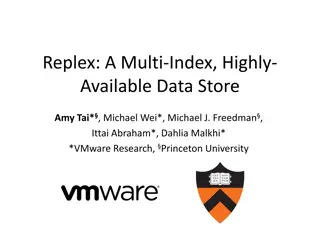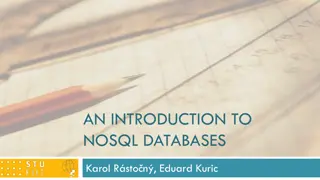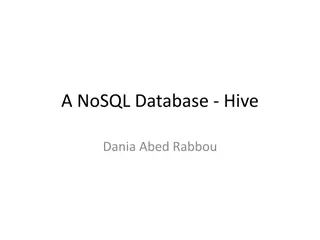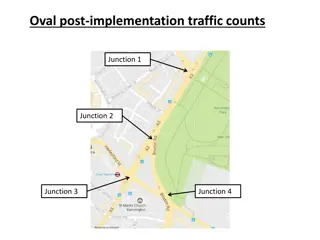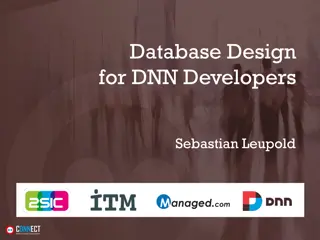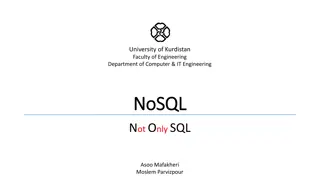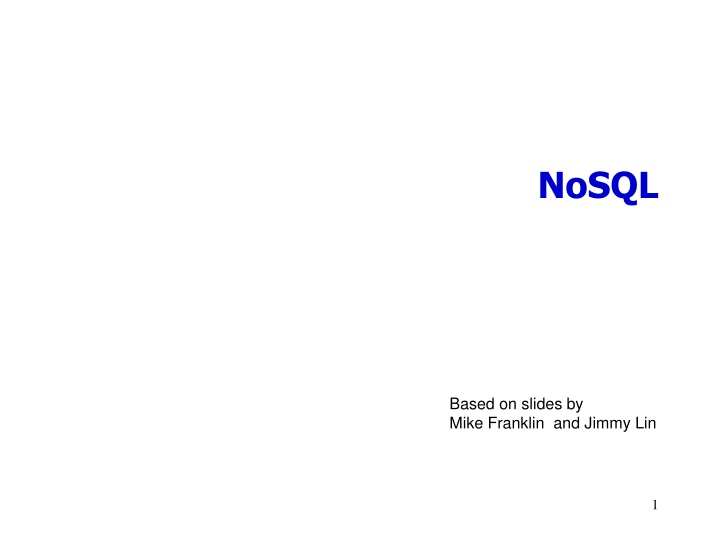
NoSQL
Explore the world of NoSQL databases and Big Data through informative slides by experts Mike Franklin and Jimmy Lin. Learn about the sheer volume of data generated daily by companies like Facebook and Google, and delve into the components and features of NoSQL systems. Understand the importance of scalability, the non-relational nature of NoSQL, and how it complements data analytics and online querying in the realm of Big Data.
Download Presentation

Please find below an Image/Link to download the presentation.
The content on the website is provided AS IS for your information and personal use only. It may not be sold, licensed, or shared on other websites without obtaining consent from the author. If you encounter any issues during the download, it is possible that the publisher has removed the file from their server.
You are allowed to download the files provided on this website for personal or commercial use, subject to the condition that they are used lawfully. All files are the property of their respective owners.
The content on the website is provided AS IS for your information and personal use only. It may not be sold, licensed, or shared on other websites without obtaining consent from the author.
E N D
Presentation Transcript
NoSQL Based on slides by Mike Franklin and Jimmy Lin 1
Big Data (some old numbers) Facebook: 130TB/day: user logs 200-400TB/day: 83 million pictures Google: > 25 PB/day processed data Gene sequencing: 100M kilobases per day per machine Sequence 1 human cell costs Illumina $1k Sequence 1 cell for every infant by 2015? 10 trillion cells / human body Total data created in 2010: 1.ZettaByte (1,000,000 PB)/year ~60% increase every year 2
Big data is not only databases Big data is more about data analytics and on- line querying Many components: Storage systems Database systems Data mining and statistical algorithms Visualization 3
What is NoSQL? from Geek and Poke 4
What is NoSQL? An emerging movement around non- relational software for Big Data Roots are in the Google and Amazon homegrown software stacks Wikipedia: A NoSQL database provides a mechanism for storage and retrieval of data that use looser consistency models than traditional relational databases in order to achieve horizontal scaling and higher availability. Some authors refer to them as "Not only SQL" to emphasize that some NoSQL systems do allow SQL-like query language to be used.
Some NoSQL Components Query Optimization and Execution Relational Operators Access Methods Buffer Management Analytics Interface (Pig, Hive, ) Data Parallel Processing (MapReduce/Hadoop) Imperative Lang (RoR, Java,Scala, ) Disk Space Management Distributed Key/Value or Column Store (Cassandra, Hbase, Redis, ) Scalable File System (GFS, HDFS, ) 6
NoSQL features Scalability is crucial! load increased rapidly for many applications Large servers are expensive Solution: use clusters of small commodity machines need to partition the data and use replication (sharding) cheap (usually open source!) cloud-based storage 7
NoSQL features Sometimes not a well defined schema Allow for semi-structured data still need to provide ways to query efficiently (use of index methods) need to express specific types of queries easily 8
Scalability Parallel Database (circa 1990) Map Reduce (circa 2005) 9
Scalability (continued) Often cited as the main reason for moving from DB technology to NoSQL DB Position: there is no reason a parallel DBMS cannot scale to 1000 s of nodes NoSQL Position: a) Prove it; b) it will cost too much anyway 10
Flavors of NoSQL Four main types: key-value stores document databases column-family (aka big-table) stores graph databases Here we will talk more about Document databases (MongoDB) 11
Key-Value Stores There are many systems like that: Redis, MemcacheDB, Amazon's DynamoDB, Voldemort Simple data model: key/value pairs the DBMS does not attempt to interpret the value Queries are limited to query by key get/put/update/delete a key/value pair iterate over key/value pairs 12
Document Databases Examples include: MongoDB, CouchDB, Terrastore Also store key/value pairs - However, the value is a document. expressed using some sort of semi-structured data model XML more often: JSON or BSON (JSON's binary counterpart) the value can be examined and used by the DBMS (unlike in key/ data stores) Queries can be based on the key (as in key/value stores), but more often they are based on the contents of the document. Here again, there is support for sharding and replication. the sharding can be based on values within the document 13
The Structure Spectrum Semi-Structured (schema-later) Unstructured (schema-never) Structured (schema-first) Relational Database Formatted Messages Documents XML Tagged Text/Media Plain Text Media
MongoDB (An example of a Document Database) -Data are organized in collections. A collection stores a set of documents. - Collection like table and document like record - but: each document can have a different set of attributes even in the same collection - Semi-structured schema! - Only requirement: every document should have an _id field - humongous => Mongo 15
Example mongodb { "_id :ObjectId("4efa8d2b7d284dad101e4bc9"), "Last Name": Cousteau", "First Name": Jacques-Yves", "Date of Birth": 06-1-1910" }, { "_id": ObjectId("4efa8d2b7d284dad101e4bc7"), "Last Name": "PELLERIN", "First Name": "Franck", "Date of Birth": "09-19-1983", "Address": "1 chemin des Loges", "City": "VERSAILLES" } 16
Example Document Database: MongoDB Key features include: JSON-style documents actually uses BSON (JSON's binary format) replication for high availability auto-sharding for scalability document-based queries can create an index on any attribute for faster reads 17
MongoDB Terminology relational term <== >MongoDB equivalent ---------------------------------------------------------- database <== > database table <== > collection row <== > document attributes <== > fields (field-name:value pairs) primary key <== > the _id field, which is the key associated with the document 18
JSON JSON is an alternative data model for semi-structured data. JavaScript Object Notation Built on two key structures: an object, which is a sequence of name/value pairs { "id": "1000", "name": "Sanders Theatre", "capacity": 1000 } an array of values [ "123", "222", "333" ] A value can be: an atomic value: string, number, true, false, null an object an array 19
Example mongodb { "_id :ObjectId("4efa8d2b7d284dad101e4bc9"), "Last Name": Cousteau", "First Name": Jacques-Yves", "Date of Birth": 06-1-1910" }, { "_id": ObjectId("4efa8d2b7d284dad101e4bc7"), "Last Name": "PELLERIN", "First Name": "Franck", "Date of Birth": "09-19-1983", "Address": "1 chemin des Loges", "City": "VERSAILLES" } 20
The _id Field Every MongoDB document must have an _id field. its value must be unique within the collection acts as the primary key of the collection it is the key in the key/value pair If you create a document without an _id field: MongoDB adds the field for you assigns it a unique BSON ObjectID example from the MongoDB shell: > db.test.save({ rating: "PG-13" }) > db.test.find() { "_id" :ObjectId("528bf38ce6d3df97b49a0569"), "rating" : "PG-13" } Note: quoting field names is optional (see rating above) 21
Data Modeling in MongoDB Need to determine how to map entities and relationships => collections of documents Could in theory give each type of entity: its own (flexibly formatted) type of document those documents would be stored in the same collection However, it can make sense to group different types of entities together. create an aggregate containing data that tends to be accessed together 22
Capturing Relationships in MongoDB Two options: 1. store references to other documents using their _id values 2. embed documents within other documents 23
Example relationships Consider the following documents examples: { "_id":ObjectId("52ffc4a5d85242602e000000"), "building": "22 A, Indiana Apt", "pincode": 123456, "city": "Los Angeles", "state": "California" } { "_id":ObjectId("52ffc33cd85242f436000001"), "name": "Tom Hanks", "contact": "987654321", "dob": "01-01-1991" } Here is an example of embedded relationship: { "_id":ObjectId("52ffc33cd85242f436000001"), "contact": "987654321", "dob": "01-01-1991", "name": "Tom Benzamin", "address": [ { "building": "22 A, Indiana Apt", "pincode": 123456, "city": "Los Angeles", "state": "California" }, { "building": "170 A, Acropolis Apt", "pincode": 456789, "city": "Chicago", "state": "Illinois" } ] } And here an example of reference based { "_id":ObjectId("52ffc33cd85242f436000001"), "contact": "987654321", "dob": "01-01-1991", "name": "Tom Benzamin", "address_ids": [ ObjectId("52ffc4a5d85242602e000000"), ObjectId("52ffc4a5d85242602e000001") ] } 24
Queries in MongoDB Each query can only access a single collection of documents. Use a method called db.collection.find(<selection>, <projection>) Example: find the names of all R-rated movies: > db.movies.find({ rating: 'R' }, { name: 1 }) 25
Projection Specify the name of the fields that you want in the output with 1 ( 0 hides the value) Example: >db.movies.find({},{"title":1,_id:0}) (will report the title but not the id) 26
Selection You can specify the condition on the corresponding attributes using the find: name: 1, runtime: 1 }) Operators for other types of comparisons: >db.movies.find({ rating: "R", year: 2000 }, { MongoDB SQL equivalent $gt, $gte $lt, $lte $ne Example: find the names of movies with an earnings <= 200000 > db.movies.find({ earnings: { $lte: 200000 }}) For logical operators $and, $or, $nor use an array of conditions and apply the logical operator among the array conditions: >, >= <, <= != > db.movies.find({ $or: [ { rating: "R" }, { rating: "PG-13" } ] }) 27
Aggregation from a collection of data. Recall the aggregate operators in SQL: AVG(), SUM(), etc. More generally, aggregation involves computing a result MongoDB supports several approaches to aggregation: - single-purpose aggregation methods - an aggregation pipeline - map-reduce Aggregation pipelines are more flexible and useful (see next): https://docs.mongodb.com/manual/core/aggregation-pipeline/ 28
Simple Aggregations db.collection.count(<selection>) returns the number of documents in the collection that satisfy the specified selection document Example: how may R-rated movies are shorter than 90 minutes? >db.movies.count({ rating: "R , runtime: { $lt: 90 }}) returns an array with the distinct values of the specified field in documents that satisfy the specified selection document if omit the query, get all distinct values of that field - which actors have been in one or more of the top 10 grossing movies? >db.movies.distinct("actors.name , { earnings_rank: { $lte: 10 }}) db.collection.distinct(<field>, <selection>) 29
Aggregation Pipeline A very powerful approach to write queries in MongoDB is to use pipelines. We execute the query in stages. Every stage gets as input some documents, applies filters/aggregations/projections and outputs some new documents. These documents are the input to the next stage (next operator) and so on Example for the zipcodes database: > db.zipcodes.aggregate( [ { $group: { _id: "$state", totalPop: { $sum: "$pop" } } }, { $match: { totalPop: { $gte: 10*1000*1000 } } } ] ) Here we use group_by to group documents per state, compute sum of population and output documents with _id, totalPop (_id has the name of the state). The next stage finds a match for all states the have more than 10M population and outputs the state and total population. More here: https://docs.mongodb.com/v3.0/tutorial/aggregation-zip-code-data-set/ 30
Other Structure Issues NoSQL: a) Tables are unnatural, b) joins are evil, c) need to be able to grep my data DB: a) Tables are a natural/neutral structure, b) data independence lets you precompute joins under the covers, c) this is a price of all the DBMS goodness you get This is an Old Debate Object-oriented databases, XML DBs, Hierarchical, 31
Fault Tolerance DBs: coarse-grained FT if trouble, restart transaction Fewer, Better nodes, so failures are rare Transactions allow you to kill a job and easily restart it NoSQL: Massive amounts of cheap HW, failures are the norm and massive data means long running jobs So must be able to do mini-recoveries This causes some overhead (file writes) 32
Cloud Computing Computation Models Finding the right level of abstraction von Neumann architecture vs cloud environment Hide system-level details from the developers No more race conditions, lock contention, etc. Separating the what from how Developer specifies the computation that needs to be performed Execution framework ( runtime ) handles actual execution Similar to SQL!!
Typical Large-Data Problem Iterate over a large number of records Extract something of interest from each Shuffle and sort intermediate results Aggregate intermediate results Generate final output Key idea: provide a functional abstraction for these two operations MapReduce (Dean and Ghemawat, OSDI 2004)
MapReduce Programmers specify two functions: map(k, v) <k , v >* reduce (k , v ) <k , v >* All values with the same key are sent to the same reducer The execution framework handles everything else
MapReduce k1 v1 k2 v2 k3 v3 k4 v4 k5 v5 k6 v6 map map map map a 1 b 2 c 3 c 6 a 5 c 2 b 7 c 8 Shuffle and Sort: aggregate values by keys a 1 5 b 2 7 c 2 3 6 8 reduce reduce reduce r1s1 r2s2 r3s3
MapReduce Programmers specify two functions: map(k, v) <k , v >* reduce (k , v ) <k , v >* All values with the same key are sent to the same reducer The execution framework handles everything else What s everything else ?
MapReduce Runtime Handles scheduling Assigns workers to map and reduce tasks Handles data distribution Moves processes to data Handles synchronization Gathers, sorts, and shuffles intermediate data Handles errors and faults Detects worker failures and automatically restarts Handles speculative execution Detects slow workers and re-executes work Everything happens on top of a distributed FS (later)Sounds simple, but many challenges!
MapReduce Programmers specify two functions: map(k, v) <k , v >* reduce (k , v ) <k , v >* All values with the same key are reduced together The execution framework handles everything else Not quite usually, programmers also specify: partition (k , number of partitions) partition for k Often a simple hash of the key, e.g., hash(k ) mod R Divides up key space for parallel reduce operations combine (k , v ) <k , v >* Mini-reducers that run in memory after the map phase Used as an optimization to reduce network traffic
v1 k1 k2 v2 k3 v3 k4 v4 k5 v5 k6 v6 map map map map a 1 b 2 c 3 c 6 a 5 c 2 b 7 c 8 combine combine combine combine a 1 b 2 c 9 a 5 c 2 b 7 c 8 partition partition partition partition Shuffle and Sort: aggregate values by keys c c 2 3 6 8 2 9 8 a 1 5 b 2 7 reduce reduce reduce r1s1 r2s2 r3s3
Two more details Barrier between map and reduce phases But we can begin copying intermediate data earlier Keys arrive at each reducer in sorted order No enforced ordering across reducers
MapReduce Overall Architecture User Program (1) submit Master (2) schedule map (2) schedule reduce worker split 0 split 1 split 2 split 3 split 4 output file 0 (6) write (5) remote read worker (3) read (4) local write worker output file 1 worker worker Input files Map phase Intermediate files (on local disk) Reduce phase Output files Adapted from (Dean and Ghemawat, OSDI 2004)
Hello World Example: Word Count Map(String docid, String text): for each word w in text: Emit(w, 1); Reduce(String term, Iterator<Int> values): int sum = 0; for each v in values: sum += v; Emit(term, value);
MapReduce can refer to The programming model The execution framework (aka runtime ) The specific implementation Usage is usually clear from context!
MapReduce Implementations Google has a proprietary implementation in C++ Bindings in Java, Python Hadoop is an open-source implementation in Java Development led by Yahoo, used in production Now an Apache project Rapidly expanding software ecosystem, but still lots of room for improvement Lots of custom research implementations For GPUs, cell processors, etc.
Cloud Computing Storage, or how do we get data to the workers? NAS SAN Compute Nodes What s the problem here?
Distributed File System Don t move data to workers move workers to the data! Store data on the local disks of nodes in the cluster Start up the workers on the node that has the data local Why? Network bisection bandwidth is limited Not enough RAM to hold all the data in memory Disk access is slow, but disk throughput is reasonable A distributed file system is the answer GFS (Google File System) for Google s MapReduce HDFS (Hadoop Distributed File System) for Hadoop
GFS: Assumptions Choose commodity hardware over exotic hardware Scale out , not up High component failure rates Inexpensive commodity components fail all the time Modest number of huge files Multi-gigabyte files are common, if not encouraged Files are write-once, mostly appended to Perhaps concurrently Large streaming reads over random access High sustained throughput over low latency GFS slides adapted from material by (Ghemawat et al., SOSP 2003)
GFS: Design Decisions Files stored as chunks Fixed size (64MB) Reliability through replication Each chunk replicated across 3+ chunkservers Single master to coordinate access, keep metadata Simple centralized management No data caching Little benefit due to large datasets, streaming reads Simplify the API Push some of the issues onto the client (e.g., data layout) HDFS = GFS clone (same basic ideas implemented in Java)
From GFS to HDFS Terminology differences: GFS master = Hadoop namenode GFS chunkservers = Hadoop datanodes Functional differences: No file appends in HDFS (was planned) HDFS performance is (likely) slower


